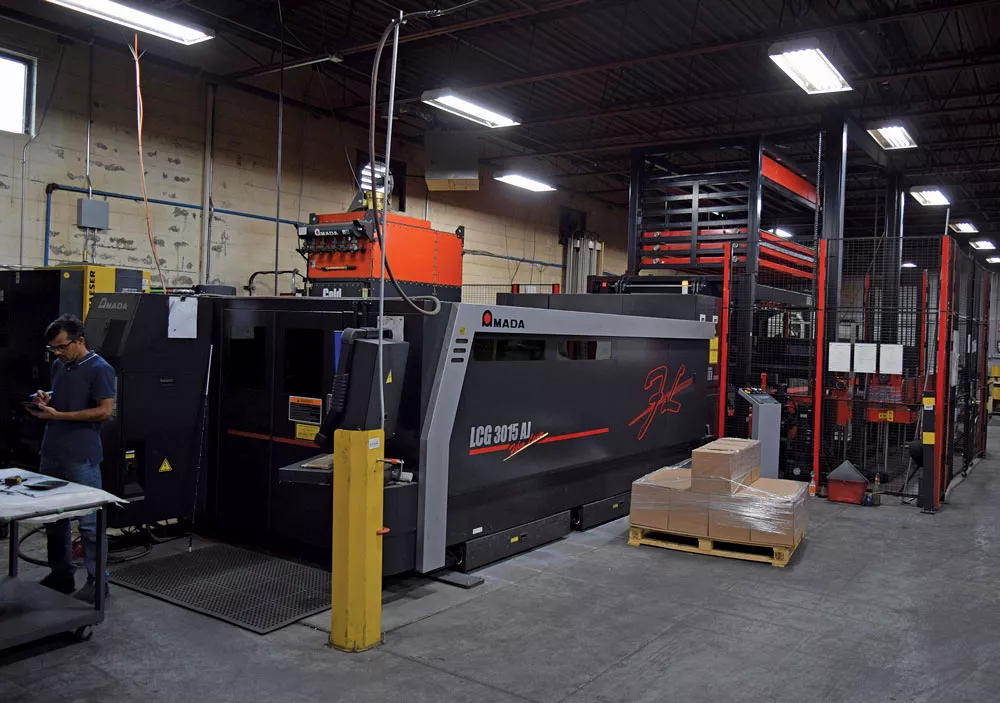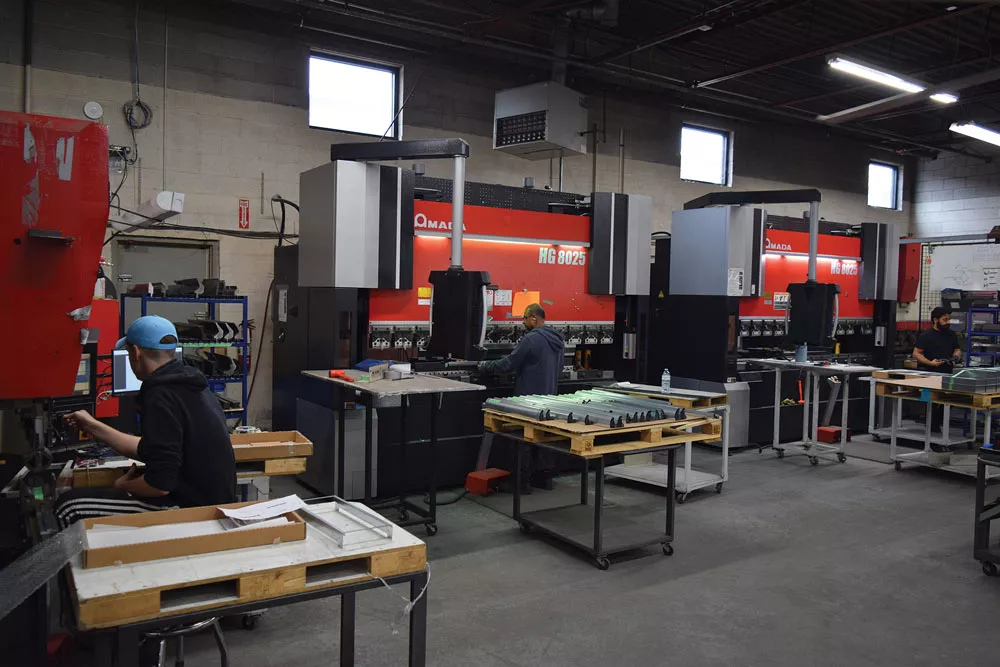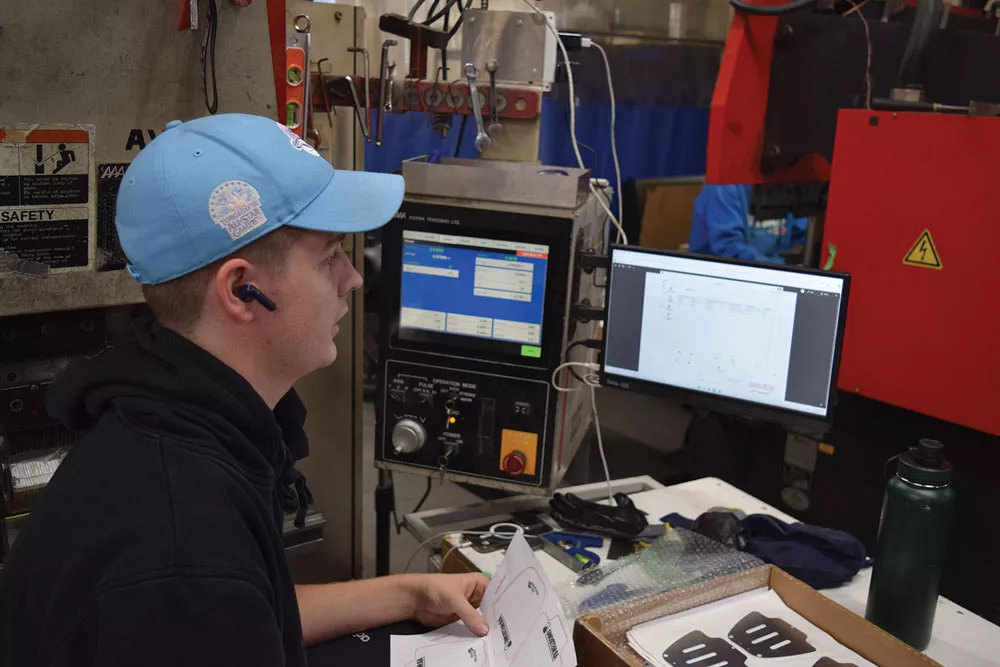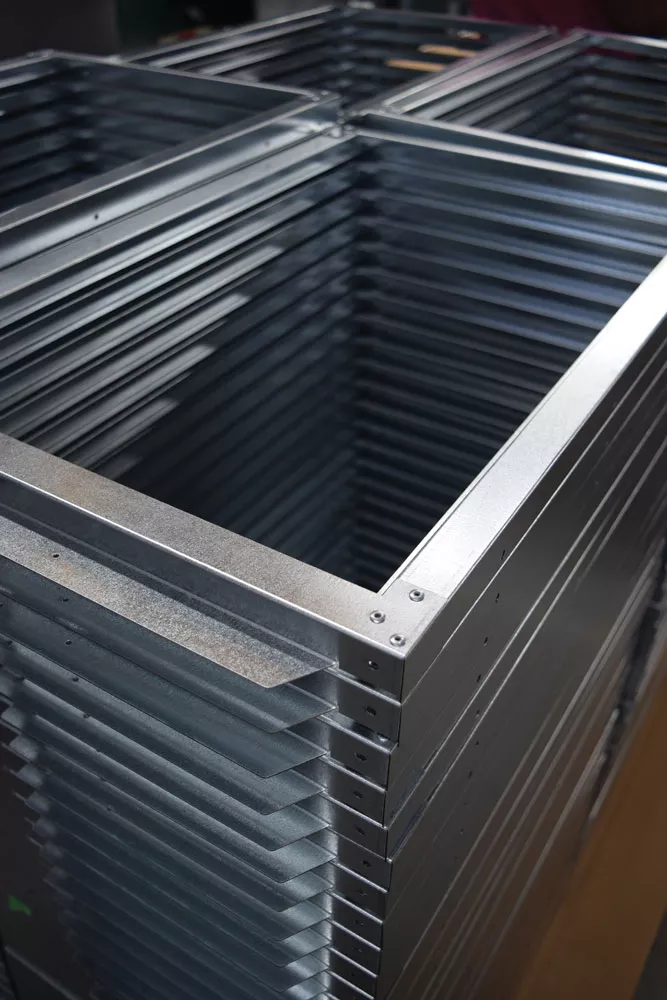A focus on shop communication is helping this fabricator improve productivity.
Investing in the right machines and software to run your shop is obviously critical to thrive. But adopting a process and developing people to manage that workflow is equally important. The best team on paper will never be as good as they possibly can without developing processes that keep information flowing to the right people on time, every time.
It’s unlikely anyone will perfect this process, but that is something that Sable Metal Fabrication is working towards. It is determined to do much more with all the tools on its shop floor today by simply improving information flow.
History and Shop Growth
Sable Metal Fabrication was established in 2004, initially providing only laser cutting. With positive feedback on deliveries from customers, the company’s reach quickly grew to include punch press, bending, riveting, spot welding, and MIG welding services.
The Markham, Ont., business has its own building and recently reclaimed the final 3,000 sq. ft. of the property to allow it to expand its welding and assembly capabilities for key clients.
Like many fab shop owners, founder and technical director Scott Harnett has a keen interest in up-and-coming technologies. For instance, he integrated a Motoman HP50 robot with a 10-ft. 7-axis Aizawa hydraulic press brake nearly 16 years ago to keep work from leaving Canada.
He’s philosophical about such investments.
“I don’t look at payback times on an investment like that,” he noted. “It has certainly paid for itself and more by now. And it helped the business at the time.”
He also is someone who doesn’t make decisions based solely on brand loyalty; it’s all about how a machine can push the company forward. For instance, a number of years ago, Harnett invested in an AMADA LCG 3015 AJ 4-kW fibre laser with a tower for lights-out operation. The laser’s power made sense for the company’s specialty (anything under ¾ in. but primarily gauge steel, aluminum, and stainless). The footprint of the machine also was a consideration.
“The machine fit perfectly into the spot where the laser we were getting rid of sat,” said Harnett. “Between that and the price, it made it an ideal fit for us.”
Harnett eventually invested in two AMADA HG 8025 press brakes as well.

“It was the off-line programming through the company’s VPSS software that convinced me to purchase those machines,” he explained. The software interprets unfold data for bend simulation and set-up generation, helping to reduce bend set-up time. “We could already off-line program the laser. We wanted to simplify workflow in the press brake department as well.”
Harnett noted that he’s been impressed by the service he’s received from AMADA.
Most recently, Sable invested in an AMADA nitrogen generator for its laser cutting machine.
“We were having supply issues and our supplier wanted us to invest in a larger tank to space out deliveries,” said Harnett. “We just don’t have the footprint for that. The nitrogen generator just made sense. Cutting with nitrogen can be more expensive, but you get a very clean edge with no oxidization in thin materials, which is our specialty. Ultimately, we want to do most of our cutting with nitrogen for the quality you achieve with it.”
Software Boost
Sable’s competitive edge comes from both the machines on the shop floor as well as the software that helps support its operations. The company has used JOBBOSS for enterprise resource planning (ERP) since the beginning. It has continued to build on this as well, with recent investments in Microsoft Teams and a Synergy CRM customer relationship management system and the introduction of monitors throughout the facility to fully connect the ERP to the shop floor.
The rollout of monitors throughout the shop floor all at the same time was thanks to the Canadian Manufacturers & Exporters Technology Investment Program (TIP).
“Without that funding, I would still be rolling that out, going two stations at a time,” said Harnett. “The funding allowed us to speed up that implementation.”
Now, all orders can be pushed out to the floor without a long paper trail. Orders are controlled centrally by one individual. Programming for the laser and press brakes are handled by the engineering team, which currently consists of one head engineer and two co-op students from University of Waterloo. Quality control, meanwhile, also is in the hands of one individual.
The CRM system is on hand to help keep customer conversations moving.
“The system reminds us of quotes that are out and encourages us to follow up on any opportunities so that they are not left to float,” said Sean Wellwood, the company’s new customer relations manager. “It will also provide reminders to follow up with customers we haven’t spoken to in some time and track orders straight from the quote right through to delivery.”

Preserving Tribal Knowledge
The investment in Teams is all about preserving tribal knowledge by centralizing all communication.
“We don’t do verbal quotes, or pen and paper orders,” noted Wellwood. “All office communication is being centralized in Teams so that everything can be tracked. No operator should be working in a silo.”
Even simple processes like ordering a tape measure are handled through Teams so that everyone gets used to entering data rather than walking into someone’s office and requesting it. Wellwood says it’s about creating the paper trail necessary to track all information in the shop.
“Scott would rather be late with something and have the process get ingrained with the team than go with the quick fix,” Wellwood said. “Team members are allowed to make mistakes. It’s a matter of learning from those mistakes and improving the system along the way. Any revisions on a part, any issues from the floor, should be coming through Teams. Every time I start to write an email I think, ‘Could this be done through Teams?’ Most of the time the answer is ‘Yes.’”
Likewise, every part has to be properly labeled with its order number or it will be scrapped.
The shop is equipped with carts on wheels that are approximately the same height to move orders from station to station in a standardized flow.
Between the streamlined online communications and the physical manner in which the parts move through the shop, management is convinced that the company can increase production substantially.
“When Scott first hired me, we said, ‘Let’s not invest in any machines for at least a year,’” said Wellwood. “When you look at the capacity of the machines, we could conceivably double the business without buying one piece of equipment. So let’s maximize the capacity by being purposeful.”
Part of this process is Wellwood searching out the ideal customers to fill that capacity. Sable once did plenty of prototype and one-off work, but now the company is geared more toward higher run orders.
“We are turning down more business now than we used to, trying to better serve the customers that suit our capabilities best—particularly those parts in the mid-range gauge thickness,” he explained. “We currently run one shift with optional overtime on Saturdays, and we keep busy all week. And of course, the laser can run lights out over night with remote monitoring. But there’s plenty of room to grow with the right mix of orders.”

Team Management
Finding and keeping good team players is key to successful growth. On its team of 20, Sable has a good number who have been with the company for many years—one or two from near the beginning of its operations.
Communication is a big part of that. Harnett tries to run as lean as possible, so he has weekly meetings where he discusses operations and plans. And instead of doing an annual review, he has quarterly reviews.
“If you only do yearly reviews, people forget what they did right or what they did wrong,” said Harnett. “This way, I can deliver discretionary bonuses quarterly and people understand clearly how I arrived at my decisions about them. It creates a better incentive to improve and keeps our goals more clearly in mind.”
The company also fosters young manufacturing talent by supporting the FIRST Robotics Competition, an international contest that teams students up with engineers and sponsors from local businesses to develop skills in science, technology, marketing, and leadership.
A student who took part in this program eventually came back to ask for a summer job, and soon after, Harnett was introduced to Waterloo’s co-op program. The company now regularly brings in co-op students to work in its engineering department.
Customer Outreach
The CRM purchase has been a boost to customer management logistics, but Sable has always had an open door for clients; the team likes to have people tour the shop so that they understand how their orders are handled and by whom. Honesty in the process is key.
“We are realistic about delivery times,” said Wellwood. “We aren’t the least expensive, but you know that it will be quality, delivered on time.”
On-time deliveries have been so consistent that the company happily publishes its stats on its website.
“We did have a month or two this year where, due to equipment issues and staff being sick, our numbers weren’t as good as usual, but we published those as well,” said Wellwood. “We need to be upfront with our customers.”
Sable’s machine purchase hiatus won’t likely last for long. Harnett is already considering how a cobot might fit in on the shop floor. He has options in terms of what tasks to assign it, it’s a matter of deciding the approach to take. This and other machine considerations are on the table.

But right now, process improvements and new customer engagements are where Sable’s energies are focused. And Wellwood says that so far, it’s paying dividends.
“We are seeing the growth we were looking for.”
Editor Robert Colman can be reached at rcolman@fmamfg.org.
Sable Metal Fabrication, sablemetal.com
AMADA CANADA, amada.ca
